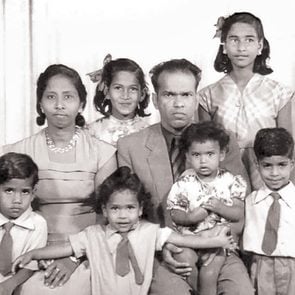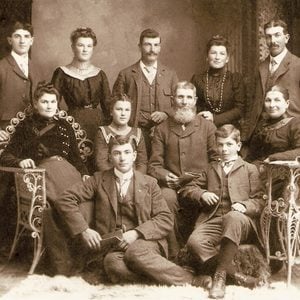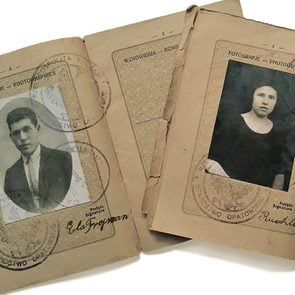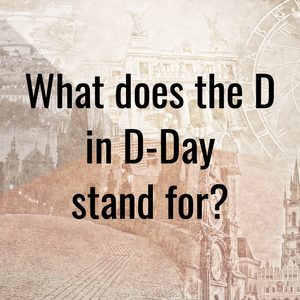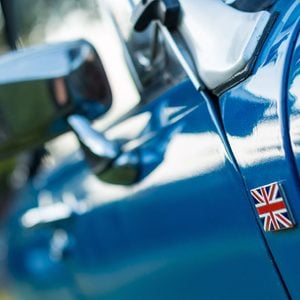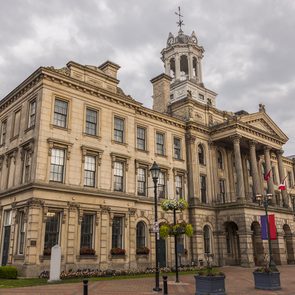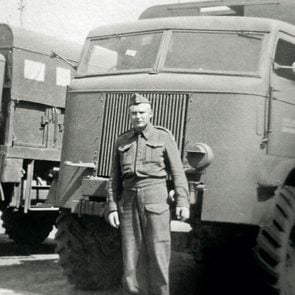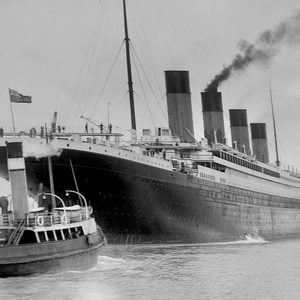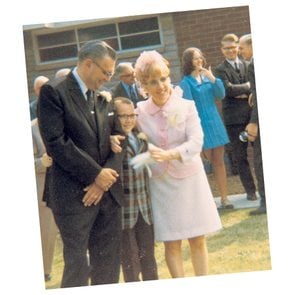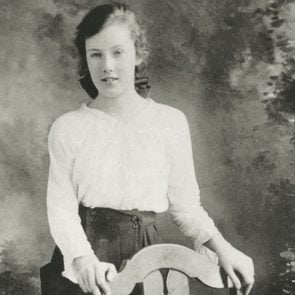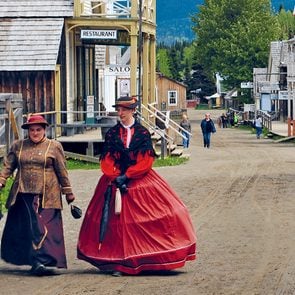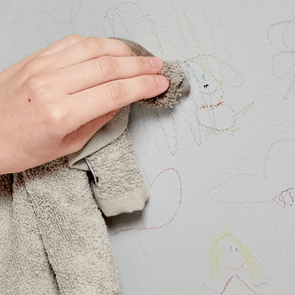As a travel writer on a months’-long assignment in Newfoundland and Labrador, I’m learning new things every day. My search for good stories, great characters and rich experiences has me touring all over, from remote Labrador communities accessible only by boat, to warm, welcoming villages with a distinctly Irish feel on the Great Northern Peninsula.
My destination today is a small outport community called Leading Tickles, just across Badger Bay from the picturesque fishing village of Triton. Riding in an open boat with Mike Roberts, a lifelong cod, lobster, crab and squid fisherman, he’s assembled a group of friends and relatives to join us on the excursion. The skies are bright, the seas are calm, the air is salty… And I have very little idea what’s going on.
As an Ontarian with the blandest accent you can imagine, the rapid chatter and quick turns of phrase on board this boat fascinate me. I’m happy to sit in the bow and watch the waves as these friends chit-chat amongst themselves in the stern, pointing to things on the shore and engaging in animated conversation. One of them cracks a joke, and everyone explodes in laughter. I just smile along.
Catching a word or two here and there, for the most part, it might as well be Russian. Roberts, showing a warmth and kindness that’s common across Newfoundland and Labrador, quickly comes over and loops me in, recounting the essence of the joke, and pointing out landmarks along the shore. It’s just one moment among many where I marvel at the linguistic texture that’s developed here over hundreds of years.

The origins of Newfoundland’s distinct language
Newfoundland and Labrador can be confusing for first-time visitors, in all the best ways. It’s a province that’s got a long and fascinating history, and a diversity of dialects to match. “People always talk about a Newfoundland accent, but there’s no such thing,” says Dale Jarvis, a St. John’s-based folklorist, self-professed “word nerd,” and executive director of Heritage Newfoundland. “There’s actually a whole pile of Newfoundland accents.”
Jarvis explains that permanent settlement in this part of Canada dates back to the 1500s. Those early arrivals from the west of England and southern Ireland brought with them accents and vernacular that were already well-established. Over time, it was modified by Innu and Inuit influences, as well as French, especially in places like the Port au Port Peninsula on the west coast of Newfoundland.
The isolated nature of the region’s small “outport” fishing communities—many accessible only by water—made them time capsules, preserving the original language and accents, even while they evolved differently elsewhere. In the southern reaches of the Avalon Peninsula, south of St. John’s, and villages like Tilting on Fogo Island, the accent tends to be Irish, with Gaelic words thrown into the mix. In Port au Port, people often speak with a French accent, even if they don’t speak French. And Jarvis notes that in areas originally settled by West Englanders, remnants of Shakespearean English remain. “People there still say things like ‘two of ye,’” he notes. “When you hear the original pronunciation, Shakespeare sounds a lot like Newfoundland.”
People here developed a sort of verbal shorthand, a quick and easy way to communicate with one another—that rapid-fire patois that often baffles visitors. But Jarvis notes that Newfoundland has long been a hub of transportation, by sea and air, and that Newfoundlanders are very adept at switching over to standard English when communicating with those who have “come from away” (more on that later). It’s a gift of the gab that seems to be second-nature when you look at the region’s rich history of storytelling, singing ballads, and more recently, stand up comedians. (Many of the country’s top comedians hail from here.) “Quickness and facility with the language, that marks Newfoundland,” Jarvis says.

Common Newfoundland sayings, decoded
Some words and phrases are often very specific to a certain place, for example the term “slue,” which around Gander can mean hello or goodbye. Added to that, many phrases are derived from this province’s inextricable link with seafaring culture. Boat captain Barry Rogers who spends his time in Twillingate and St. John’s, gives one example. “If I went down to the boat in the morning and the lads are lying around, I’d say, ‘What are you, draw-latching?!’” Commonly used around Twillingate, the term refers to the wooden latch on a fishing stage (often drawn open with rope or twine), and roughly translates as “loafing.”
Moving across the province, I’ve heard certain terms again and again, compiling a small list along the way. Local friends were happy to weigh in, adding their favourite expressions. Altogether, it formed a handy little lexicon to help navigate the local linguistic tides. Here’s just a small primer to get you started, for when you visit:
Come from away: Sometimes shortened to just “CFA,” this phrase, used as the title of a Tony-award winning Broadway musical, applies to anyone not from Newfoundland and Labrador. (If you’re a visitor, that’s you.) For example: “Are you come from away?” or “You know Tony? He’s from away.”
B’y: A contraction of “boy.”
Yes b’y: Generally a term of agreement, but very versatile. It can express a wide variety of things, from sarcasm to frustration to astonishment, even disagreement.
Deadly: Really good, almost to the point of being dangerously good. As in, “Have some of these cheezies—they’re deadly.”
What y’at: A contraction of “What are you at,” it’s a form of greeting, the equivalent of asking, “How’s it going?” There are only two standard replies: “Nothin’” and “This is it!”
Adding “some” before a word: Emphasizes and underlines the word that follows. For example: “That storm last night? It was some awful.”
Buddy: A general term for a random dude. Example (if telling a story): “So, buddy was out there in his boat…”
Buddy Wasisname: Useful when you can’t remember someone’s name. For example, “Remember buddy wasisname? He was in that movie…”
Best kind: Very good, often referring to people. For example: “You know Mary? She’s best kind.”
And, if you’re feeling a little confused—just ask. Most Newfoundlanders will be more than happy to provide an explanation of anything you don’t understand, often accompanied by a colourful story. Because everyone here is best kind.
Now that you’ve got these Newfoundland sayings under your belt, read the heartwarming story that will convince you that Newfoundland is the kindest province.

While reading my favourite magazine, Our Canada, some of the stories stirred up memories of my own. My parents came from Europe to Canada in 1929. They planned to be farmers around Winnipeg, but circumstances brought them to Kelowna in British Columbia. They spoke no English, but fortunately found work with a German-speaking family who needed help with their farm animals, small orchard and several children. These two families, strangers at first, became lifelong friends.
Within a year, my dad found a new opportunity in the form of a large, derelict bunkhouse that was for sale. It was two storeys, had 20 individual rooms, a huge community kitchen and dining room, plus a row of outhouses in the backyard. It was owned and operated by a nearby cannery, which no longer needed to import seasonal workers, as Kelowna now had a growing population of immigrants who eagerly lined up each day hoping to be chosen for work. My parents also lined up and were fortunately good workers who were retained for the season.
Obviously, the sale of the bunkhouse became a big topic of discussion—especially when my dad said he would buy it! Why not? After all, he had just received his “refund” of the money he had to deposit to ensure he would become a working immigrant in Canada.
The bunkhouse was not particularly clean, so both of my parents scrubbed and calcimined each of the rooms. Even so, they would soon be fighting a bedbug war every time a tenant moved away.
The building was near the train station, and men looking for work were arriving daily. The rooms rented for $5 per month and were about 12 feet by 12 feet in size. They were furnished with a cot and mattress, a washstand with basin and bucket, two chairs, a homemade table and tongue-and-groove shelves for groceries, dishes and whatever. Clothes were hung on hooks behind the door. One electric light hung from the ceiling. Cold water was available from a tap in the yard and a small cast iron stove was used for heating and cooking, with wood included in the rent!

No Place Like Home
One of the elderly bachelors living on the shadier north side of the building had no money to pay rent, so Dad’s advisers/translators told him that this man would have to go. My dad refused to evict him. Old John paid his back rent in installments as soon as he began to receive his meager old-age pension. Mom insisted he keep some money for groceries. He was a quiet old man and became my “grampa.” Old John lived with us until his death some 15 years later.

As time went on, my parents upgraded the old bunkhouse and we re-christened it “The Northern Rooms.” Bachelors were finding wives, so Dad would make a door between north and south rooms. Now they had a separate bedroom-storage area plus a kitchen-living area. When sewers were extended to our street, we added indoor plumbing for men and women. On the upper floor were private cubicles for bathtubs. Dad also installed a stove and a wringer washer. All the women loved him for that! By now there were babies around and diapers to launder.

Our original living quarters were now rented out as well. Mom and Dad had salvaged wood and straightened nails from a demolished shed nearby. From that, they built a modest two-bedroom home, sized according to the available wood! Tiny closets were ample for our few clothes, and we also had indoor plumbing with a Pembroke bathtub. Mom never stopped praising her built-in porcelain kitchen sink with its drainboard. More than 50 years later, when this old house was to be demolished, my daughter, Susan, was able to salvage Mom’s sink. It is now used to wash vegetables from her garden!
There are many stories of all the people who lived in The Northern Rooms during the 15 years our family was there. Since our own home was built right beside it, we were always a part of this big multi-national family. We had no “landlord versus tenant” squabbles. Even after moving away, many tenants remained lifelong friends. Many became businessmen and leaders in our city.
What had been a most unlikely purchase by an uninformed immigrant, turned out to be a stepping stone to success for our family and for many of the young and old who lived with us during those many exciting and happy years.
Next, read the incredible story of how one Dutch family survived WWII to start anew in Canada.
Richard Danzer first cheated death in 1962. As a young American fighting in the Vietnam War, he was tasked with salvaging a ship that ran ashore on the island of Phú Quôc. Danzer and 10 fellow soldiers freed the vessel from the beach, but to save themselves, they needed to brave waves nearly four metres tall in a small rubber raft before North Vietnamese forces descended on them.
Danzer didn’t think they’d survive, but against all odds, they reached the ship and climbed aboard. “Every day since, I’ve thanked God,” he says. “And every day that I see sunshine is a good day.”
That attitude has helped Danzer navigate the choppy waters of aging. Now 79, he’s retired in Delray Beach, Florida, after a 50-year career working in sales and management in the paint industry. His wife has Parkinson’s disease and dementia, and he’s had plenty of health issues himself. In 2017, he was diagnosed with bladder cancer. While treating that illness, his doctors discovered and excised a squamous-cell carcinoma on his nose—a common but aggressive form of skin cancer that appears as a crust and can spread to other parts of the body if not treated. Once he was declared cancer-free, he began attending regular appointments to make sure he stayed that way.
The lump
In the summer of 2018, Danzer noticed a small lump in the middle of his back. It wasn’t painful, but over the course of a few weeks, it grew large enough that he could no longer comfortably sleep on his back. When he reported it to his general practitioner, the doctor said it was most likely a cyst, perhaps a benign pocket of fatty tissue or an inflamed hair follicle—in other words, something to keep an eye on but not a cause for panic.
The supposed cyst continued to grow for six months. By December, it was eight centimetres wide—about the size of a baseball cut in half. That wasn’t all. A sizable dark red crust was also developing on Danzer’s leg, like a scab but without any inciting scrape. He asked his daughter, Cheryl, who’d moved in with him a few years before, to take a look at his leg and back. “We both agreed that I’d better get to the doctor,” he says.
Danzer’s GP referred him to a dermatologist, Dr. Brittany Smirnov, who in turn sent him to a specialist in nearby West Palm Beach who could perform Mohs surgery, an exacting technique to remove cancerous cells from skin. Danzer also asked Smirnov to check out the growth on his back.
The diagnosis
Immediately, Smirnov was certain it was not a cyst. There was no punctum, the small hole that’s typical on a cyst caused by a problematic follicle. And the growth was firm, like a rubber eraser, whereas cysts are usually soft and gelatinous, like pudding inside a water balloon. Nor did the lump have a foul smell, another telltale sign of a cyst that results from a buildup of hair-lubricating fluid under the skin. Plus, it had grown faster than most cysts would have.
After dismissing that diagnosis, Smirnov thought it might be a lipoma, a common and benign buildup of fat. She pushed the lump around with her fingers—lipomas shift easily under the skin with slight pressure—but the bulge stayed put. It seemed affixed to the back of Danzer’s rib cage.
Still puzzled, Smirnov asked Danzer about his general health. Had he lost weight? No, he said. Was he experiencing any new issues? Nothing new, he reported, but he did have a chronic dry cough he attributed to smoking a pack of cigarettes every day for more than 40 years. That discovery flicked a switch in Smirnov’s brain. Skin abnormalities are occasionally a sign of lung cancer, a plausible diagnosis for a long-time smoker like Danzer. “One of the areas where lung cancers love to metastasize is on the chest wall,” says Smirnov.
Smirnov ordered a spiral CT scan of Danzer’s lungs. The results proved her suspicions were correct: he had stage four lung cancer, and cancerous cells had spread from his lungs to the tumour on his back. In all likelihood, Danzer’s medical team concluded, he had 18 months to live.
The treatment
“It was a shock. It didn’t immediately register,” he says. Then, when the news did start to sink in, he “put it in God’s hands.”
There was a slim chance that, with the right treatment, Danzer could cheat death again. He underwent chemotherapy and five rounds of CyberKnife treatments, in which a robotic arm zapped his tumour with targeted beams of radiation. Almost immediately, the lump on Danzer’s back started getting smaller.
“As the tumour on his back started shrinking, we knew his internal tumour was shrinking, too,” says Smirnov. “It was a really good barometer to tell us how well the cancer was responding to the treatment.”
Within two months, the growth was gone, leaving only a skin wound; with a topical solution, that healed within a few days. The chemo lasted several months, during which time Danzer often felt sick to his stomach and depleted of energy. His daughter fed, comforted and took care of him. “I don’t know where I would have been without her,” he says.
About a year after Danzer first visited Smirnov’s office, he was declared cancer-free yet again. In the summer of 2020—the season he wasn’t supposed to live long enough to see—he was back to enjoying retirement and spending time with his daughter, relieved to be alive and grateful to Smirnov for saving his life. “I’ve exceeded my check-out date by a year and a half now,” he says. “I figured, after Vietnam, I was on borrowed time anyway. This just came as another blessing.”
Next, find out 20 symptoms you should never ignore.
Hair loss is often begrudgingly accepted as a natural part of life. After all, most people, women included, will lose some or all of their hair as they get older. But when hair loss happens suddenly—handfuls of hair falling out in the shower or while brushing—it can be truly distressing. It can also be a signal of a health issue that needs to be addressed. (Here are 20 symptoms you should never ignore.)
Why is my hair falling out?
To understand why unexpected hair loss happens, it’s useful to know the growth cycle of healthy hair. Usually, most of your hair is in a growing phase, during which strands lengthen by about 1.25 centimetres a month. This part of the cycle carries on for between two and eight years.
After that, there’s a middle phase, lasting about three weeks, during which the hair isn’t getting longer but also isn’t falling out. Finally, strands enter a resting phase, where the hair is loosened but sits in its follicle. Then, when the follicle begins to grow a new hair, the old one drops out.
Due to this cyclical process, we all lose up to 100 strands of hair each day. “At any one time, about 10 per cent of our hair is in the falling out phase,” explains Jennifer Jones, a dermatologist who practices in London, England, and is an advisor to the British Association of Dermatologists.
When that balance is disrupted, a person can have too much hair in the resting phase—and a few months later, he or she might find a large amount of hair falling out all at once.
One of the main triggers for this disturbance is hormonal changes in the body. Estrogen keeps hair in the growth phase, while androgens shorten the growth cycle. For this reason, giving birth and thyroid issues—both of which shift the balance more toward androgens—can cause hair loss. “Stress is also a massive trigger,” says Jones. “So life events like divorce, bereavement or even moving house have this effect.”
Another common culprit is autoimmune conditions, most notably alopecia. This condition, which affects two per cent of people worldwide, runs in families and can be activated by a stressful event. In some cases, alopecia is subtle; other times, sufferers lose all their hair—including their body hair, eyebrows and eyelashes. Patches of alopecia tend to grow back, while full-body loss is usually permanent.
Scarring from other autoimmune conditions—including eczema, psoriasis and lichen planopilaris—can lead to patches of hair loss. Similarly, ringworm, a fungal infection, can affect the part of the head that it appears on.
Some people on prescription drugs also experience a disruption of their growth cycle. For instance, hair falling out is a known side effect of some blood pressure medications, statins and hormone replacement therapy, among others. “If you notice hair loss, discuss it with your doctor,” says Jones. “We can often switch medications.”
Treating sudden hair loss
Treatment depends on the underlying cause. To discover that, a doctor might order blood tests, perform a small skin biopsy or examine the hairs under a microscope. If the loss is hormone- or stress-related, it is usually temporary, and resolves within a few months without any intervention.
For cosmetic solutions, topical steroids can help thicken hair, and hair transplants are another option. Some people, of course, simply embrace their baldness.
Next, check out 11 natural remedies for hair loss that are worth trying.
It’s no secret that Americans spell a few words differently than us Canadians. Head south of the border and “colour” becomes “color” and “litre” becomes “liter,” among others. So how did our spellings become so varied? Turns out, there’s just one person to blame: Noah Webster, of Merriam-Webster dictionary fame.
Up until the late 18th century, people didn’t concern themselves with how words were spelled, explains BBC America’s Anglophenia. Because only the most highly educated citizens learned to write at all, spoken word was much more important to them than any type of “proper” spelling (just read a conversational letter from the time if you need proof). That’s until British lexicographer Samuel Johnson published his A Dictionary of the English Language in 1755. It took a few decades to catch on, but eventually, the Brits were making serious headway toward uniform spelling.
By the time Johnson’s Dictionary had gathered momentum, the Americans were stirring up trouble. After deciding they wanted to be their own country, it only seemed natural that they should have their own spellings, too. Noah Webster led the charge. “As an independent people, our reputation abroad demands that, in all things, we should be federal; be national,” he wrote in a 1789 essay urging spelling reform, “for if we do not respect ourselves, we may be assured that other nations will not respect us.”
Clearly, spelling was a hot-button issue. In order to differentiate American English from British and Canadian English, Webster wanted the American version to be free of the “clamour of pedantry” he thought marked the English language. That meant removing the superfluous letters in words such as “colour” and “programme.” Webster made these spellings official with the first American dictionary, A Compendious Dictionary of the English Language, published in 1806.
With their new dictionary and truly patriotic spellings, the American people were able to move forward as an independent country.
Next, see if you can pass this quiz of fourth-grade spelling words.

If ever there was an ideal plot for a blockbuster movie, it is the life story of Fern Blodgett Sunde. There is little mention of her in history books, yet she blazed a bright path for future generations of women to follow.
Fern Blodgett was born in 1918 and moved to Cobourg, Ontario with her family at a young age, from Regina, Saskatchewan. She was drawn to the Lake Ontario shoreline, where she was fascinated by passing boats. When war was declared in 1939, her sense of duty compelled her to sign up for a wireless operator course. She was refused admittance to the first two training schools she applied to but was accepted by the third.
Upon completing her course, after 18 months of night school (Fern worked as a stenographer during the day in Toronto), she travelled to Montreal and applied for a position as a wireless operator aboard the M/S Mosdale, a Norwegian merchant ship/food carrier. Captain Gerner Sunde was surprised to discover a woman among the applicants. Fern was both a qualified and determined young woman, with her Second-Class Wireless Operator’s Certificate in hand. Once hired, she became the first woman to ever hold that position. Canada and Britain did not allow women aboard warships at sea. Norwegians, however, did not have that restriction.
There were many hurdles she faced along the way. Not only was she working in cramped quarters and learning a new language, she was the only woman aboard—and seasick to boot. The nickname for any operator was Sparks, and it so perfectly described Fern.
Her work consisted of “listening” non-stop on the ship’s radio for coded messages that were received in different combinations of short, medium and long waves. Accuracy was essential. The pay for this life-threatening occupation was $170 per month, plus her board. Her home was a tiny cabin in a 3,000-tonne freighter. Her travelling companions were a crew of 35 men and, from time to time, up to 12 passengers. Eventually two more radio operators were added to the crew.
The Mosdale sailed a total of 96 transatlantic voyages. Fern travelled on a staggering 78 of those sailings. We will never know the number of times the Mosdale was threatened and how many times their voyage through dangerous waters would lead Fern to reconsider her life’s work.
Now here is the fairy-tale twist: When Fern and Captain Gerner Sunde first met, she was 22 and he was 31. He was tall, blonde and Hollywood-handsome. Fern and Gerner fell in love and they were married in Saint John, New Brunswick, one year later. No white picket fence for this young lady, however, Fern moved into the Captain’s quarters and they set up their first home—at sea!

In 1943, Fern was the first woman to receive the Norwegian War Medal. In 1952, she retired and settled in her husband’s hometown of Farsund, Norway, where the couple would go on to raise two daughters. Sadly, Gerner died in 1962.
Fern’s accomplishments at sea during World War II caught the attention of Cobourg resident Leona Woods, who assembled a dedicated committee to honour Fern’s legacy. In the midst of a global pandemic, a statue was unveiled on the beach in Victoria Park, a location chosen with considerable care.

“Making Waves,” the Fern Blodgett Sunde Monument, created by Ontario sculptor Tyler Fauvelle, is an inspirational tribute to this valiant woman. During the solemn ceremony held on Saturday, October 17, 2020, a Canadian Coast Guard vessel (anchored just off shore), and its entire crew, stood at attention.
Leona Woods states, “Fern was a Cobourg girl whose story is of national and international importance. She connects Canada with her ally Norway. She represents the veterans who participated in the Battle of the Atlantic. She speaks to the need for us to continue working for gender equality, and respect for all people in our society.”
Bravo to the courageous Fern Blodgett Sunde, who indeed did make waves!
Next, read up on 10 more great Canadian women you didn’t learn about in school.
Demonstrate, demonstrate, demonstrate! Those motivating words were coming from our instructor, and were directed towards me and a half dozen other young men gathered at the rear of a narrow storefront office on Water Street in St. John’s. The year was 1971, and although I had already established my own cleaning business, I needed to supplement my income to provide for my growing young family. Selling Electrolux vacuum cleaners door-to-door presented an exciting challenge to me.
Because I had listened intently to those words of my instructor, for many years to follow it often meant food on our table. Let me give you an example. One day, I stopped at a drive-in restaurant. The owner invited me in, but I was disappointed that there was no carpet to be seen anywhere. Even so, those words kept going around in my head: demonstrate, demonstrate, demonstrate. So, I removed the vacuum from the box and put all the parts together, explaining the best I could how each attachment worked. Looking back, 50 years later I can still see that lonesome Electrolux vacuum sitting in the middle of the room looking like it had been abandoned in the middle of the Sahara Desert.
You wouldn’t believe the customer’s next words: “How much?” To my surprise and delight, I was able to write “Paid in Full” on his receipt. This was a second surprise because most people back then just made payments of $10 or $15 a month.
Another instructor taught me a positive slogan: “If you try, you might; if you don’t, you won’t.” Those words proved true over and over again. At first the householder would say, “I’m not interested, I have a vacuum cleaner,” but if you could persuade them to see it demonstrated, one out of three would buy the Electrolux, the “Cadillac” of vacuum cleaners.
Kudos and Mishaps
When I moved my young family to Winnipeg in 1975, I continued selling Electrolux door-to-door for two years. Not long after our arrival, I went out selling one day, got lost and sold two vacuum cleaners. At our “revival meeting” the next morning I was the centre of attention. The sales leader said, “Look at Prince, a goofy Newfie, just arrived from Newfoundland, goes out yesterday, gets lost, sells two vacuums! What’s the matter with you guys?” But let me tell you, although I was the good guy that day, I was not given such high honour on other occasions.
One of my first trips out in the country was in springtime, when I was introduced to the “joys” of Manitoba gumbo. The customer’s house was at the end of a long driveway. I barely got off the main road when all four wheels disappeared into that muddy, greasy mess. After walking about a mile, I found a garage, and its owner came to my rescue. With much difficulty, he managed to tow me back on to the main road again. How could I make such a mistake? Well, don’t forget, I grew up on The Rock; I had never heard of Manitoba gumbo.
At the time, other companies marketed their vacuum cleaners the same way, door-to-door. I recall how I would sometimes squash the competition. One particular model was big, heavy and noisy, so I would tell them it would make a good anchor for their boat; what they actually needed was an Electrolux. In fact, I remember taking one such competitor’s model on trade, with a price tag still dangling from the handle. Yes, being a vacuum cleaner salesman you have to have a sense of humour and be able to shoot a lot of propaganda.
We not only sold vacuum cleaners; the Electrolux line also included a “floor conditioner” that would strip and wax floors and shampoo carpets as well. The first time I demonstrated the conditioner by shampooing a lady’s carpet. I thought to myself, “This carpet is really looking good,” but then I just about fainted when I realized that I had put wax stripper in the tank instead of rug shampoo. The lady was very pleased with the job I had done, and why shouldn’t she be—after all, she had the cleanest carpet in town! Let’s hope that years later, when the rug disintegrated, the kind vacuum cleaner salesman was long forgotten.
Good Memories
It can be a little discouraging if you go a week without selling. I was having such a week when my sister, Anita, and her husband, Dave, came to visit us from Pennsylvania. One evening, Dave offered, “I’ll come along and keep you company.” We drove out to Selkirk, where I‘d had success on other occasions. Dave said, “I’ll go for a walk while you make some calls.”
Well, at the very first call I made, a friendly school teacher and his wife invited me in and I made the sale. In the meantime, I had the left car doors locked and poor Dave was fighting off swarms of mosquitoes. However, when he heard I had made a sale, he soon forgot the bites that were covering his mangled head. I guess you can understand why he was, and still is, one of my favourite brothers-in-law.
My loyalty to the older model Electrolux made in the ’60s and ’70s is still part of me. In fact, on an early Saturday morning you might find me dashing from one garage sale to another to try to find an Electrolux that I or one of my buddies sold nearly 50 years ago. Over the years, I’ve probably owned, for my cleaning business, over a hundred of them. Sometimes, people will remark on the age of a vacuum I’m using, saying, “Boy, that’s really old; my grandmother had one like that.” I’m happy to reply, tongue in cheek, “I made my first million with one like this!”
When you’re young and have little mouths to feed at home, you would do just about anything to provide for them. I’ve had a successful business all my life, but the positive attitude taught me in my younger years selling vacuum cleaners door-to-door was a great contribution to that success.
I’m getting older, but my memory’s still sharp. My wife and I will be driving down a street and I’ll point to a house where I sold an Electrolux, and over there another one. She politely says, “Yes dear,” but she’s not quite so long-suffering when we drive by the office and I tease her by saying, “I think it would be neat to sell Electrolux again.”
“Do you want a divorce?”
We have a good laugh and I keep driving because, after 56 years of marriage, I know I’ve got a good woman. As we head home for a cup of tea I think of the favourite words of a well-known sports announcer here in Winnipeg, the late Jack Wells: “And it turned out nice again!”
Next, check out 10 classic TV shows that could only have been made in Canada.
First published in the October/November 2017 issue of Our Canada.
Prospectors came to British Columbia for the gold, and settlers came to the Chilcotin for the land. The First Nations Tsilhqot’in (Chilcotin) people inhabit the land stretching between the Fraser River and the Coast Mountains in the interior of the province.
British Columbia was one of the last frontiers to be explored in North America. The first European explorers to visit the Chilcotin were Sir Alexander Mackenzie and his voyageurs on the last leg of their historic journey crossing the North American continent in 1793. It wasn’t until 1829 that the Chilcotin people had regular contact with Europeans, when the Hudson Bay Company built the Fort Chilcotin fur trading post.

The “Freedom Road” links the Chilcotin to the Pacific Ocean. It starts in the B.C. interior town of Williams Lake. Heading west, the 456-kilometre highway crosses the mighty Fraser River and climbs up to the rolling hills of the Chilcotin Plateau, where thousands of cattle roam the grasslands. It extends to the alpine meadows of Tweedsmuir Park, then descends through the Coast Mountains to the village of Bella Coola. The last, steep section of highway (18 per cent grades in places) from Anahim Lake to the Bella Coola Valley was completed by the local people in 1953, giving them access to the interior villages of Anahim, Nimpo Lake, Tatla Lakes, Redstone, Alexis Creek, Riske Creek, Hanceville, Williams Lake and beyond. This was their road to the outside world.
The gold rush of the 1860s brought thousands of gold-seekers and adventurers from around the world to the interior of British Columbia. Settlers came from Europe, built homesteads and started ranching to supply beef for the Cariboo Gold Rush towns of Horsefly, Quesnel and Barkerville, and into the Yukon Territory.

The Chilcotin is known as “cattle country.” Descendants of the original pioneers still operate their family ranches, and evidence of this is visible on the Freedom Road (also known as Highway 20). Working cowboys and cowgirls ride the range of the Chilcotin Plateau. Ranchers use the main road to move their cows on horseback from the winter rangeland to their summer meadows and back in the fall, just as they did more than a century ago.

Driving the Freedom Road in October, we were mesmerized by the fall colours lining the Chilcotin River. This time of year, ranchers are working the fields, putting up hay to feed their cows and horses over the cold winter months. The highway crosses the heart of the Chilcotin, where the wildlife have no borders. As well as seeing cows and horses on the road, we encountered deer, bear and moose.

Old homesteads, barns, equipment and fences dot the Freedom Road. Here, communities and villages are named after the pioneers and First Nations chiefs that settled the area. This is a part of the Wild West where deals are still made with a handshake, neighbours help neighbours, and cattle drives are a spring and fall ritual.
Families and friends have been getting together since the first pioneers came to this area in the 1800s. Surnames such as Graham, Bayliff and Bliss are household names in the Chilcotin. These families have strong ties to their heritage, and their legends live on.

The old log hospital turned 100 years old in 2014 and is still in operation. The land it sits on was donated by Alexis Creek pioneer Alex Graham. Family relative Val Telford manages the volunteer visitor information centre across the highway from the hospital and has many stories from the early pioneers. The Graham Inn at Tatla Lake is a historical landmark and operates as a restaurant in the spring, summer and fall seasons.
Hugh Peel Lane Bayliff came to British Columbia from England in 1882. His ancestors included Sir Robert Peel, who twice served as prime minister of the United Kingdom in the 1830s and ’40s.
Hugh Bayliff bought a piece of property next to the scenic Chilcotin River near Redstone, and started the Chilanko Ranch. Five generations later, ranchers are still raising cattle, cutting and baling hay, and moving cows by horseback on the old wagon roads built by their forefather.

Legendary 90-year-old working lady rancher Nives Bliss runs the Bliss Ranch. She operates and services her tractors, builds and fixes fences, and uses a power saw when needed. The history of this family in the Chilcotin goes back to 1903, when William Henry Bliss was hired by Reginald Fitz-Nigel Newton to bring the first Arabian stallion from England into the territory to raise polo ponies.

The old Bliss homestead and first school in the area are still standing on the property next to the historic wagon road known as the Chilcotin Highway.
Travelling through the 300 kilometres of grassland of the Chilcotin Plateau, you start to visualize some of the hardships of the first pioneers and gain respect for the families that have endured the changing times of the cattle business. This is a land with no boundaries, where the pioneering spirit lives on and legends are born. This is one of the last true frontiers where you can live the adventures of Canada’s Wild West.
Next, explore the abandoned village of Bradian, BC’s most famous ghost town.
There is no country known as “America.” America does exist, however, in a strictly geographical sense. For residents of the United States, however, America is seemingly synonymous with the name of their country of residence. But, strictly speaking, “America” or “the Americas” is a geographic term, while “The United States” or “The United States of America” is a political term.
Now that the stateside parallel is established, it’s time head across the pond to address the usages of Great Britain vs. the UK, or United Kingdom. The difference between the two, at least in the modern day, is also based in political and geographic naming.
Great Britain is another name for the island of Britain, which, politically, is composed of Wales, Scotland, and England. When used in a political sense, it extends the island’s boundaries a bit to include some outlying islands, such as Anglesey and the Isle of Wight.
The United Kingdom, however, does not cut both ways, as it is a purely political term. The UK is an independent country composed of Scotland, Wales, Northern Ireland, and England. All of Great Britain is within the United Kingdom, but the United Kingdom is not 100 percent composed of Great Britain. Make sense?
[Source: Encyclopedia Britannica]
Heading across the pond yourself? Be sure to check out the top 50 London attractions.
There’s a satisfactory feeling that comes with finishing a cleaning project, the kind that leaves your appliances sparkling clean and your house smelling fresh. But most of the time, the only feeling that comes with cleaning the bathroom is dread. The scrubbing, the rinsing, the strong-smelling products—it’s a lot.
To help you out, we’ve covered plenty of bathroom cleaning hacks in the past, and even revealed what that pink slime is. Today comes another inexpensive bathroom cleaning trick: dishwasher tablets in the shower to help remove soap scum.
How to use dishwasher tablets to clean the shower
You’ll need a handful of materials for this hack—a pressed-powder dishwasher tablet, warm water and rubber gloves.
This cleaning hack may be cheap, but it will require vigorous scrubbing. Once you have your materials assembled, dunk the dishwasher tablet into warm water, letting it saturate before scrubbing away at the soap scum on the walls, fixtures and glass in your shower.
This may take some time depending on the state of your shower, and you’ll have to experiment on what scrubbing motions and methods work best. After some time, rinse the area off with hot water, and repeat the process with any leftover scum. That’s all there is to it!
Does it really work?
The short answer is yes, but it depends on two things—how bad the soap scum buildup is in your shower and how much patience you have.
Because dishwasher tablets are small, they cover a very small surface area when you’re on your hands and knees scrubbing away. It might take some time for the surfaces to sparkle again, but as long as you’re ready to put in the effort, the tablets should clean up your shower without breaking the bank.
Next, find out how to use dishwasher tablets to clean your oven.



